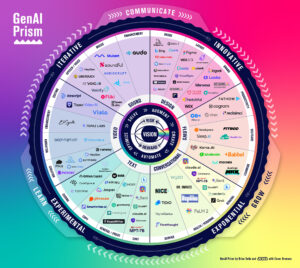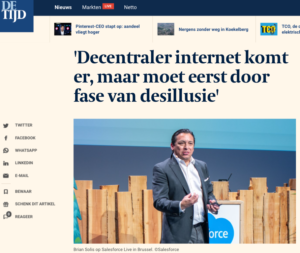
Follow me on Twitter! Become a fan on Facebook!
It seems that everywhere you turn, businesses, media properties, and brands are asking us to connect with them in the social Web. Whether it’s on TV, in press materials, advertising, or email, brands are vying for our “friendship.”
In July 2009, Bill McCloskey in partnership with StrongMail, analyzed the email marketing campaigns of top brands and how they integrated social profiles into the marketing presentation. McCloskey observed that top brands were reviving email campaigns with the inclusion of links to social profiles, specifically Facebook, Twitter, and also MySpace.
McCloskey reported that top brands such as Nike, Intel, The Gap, Pepsi, Sony, HP, Home Depot, Lane Bryant, Circuit City, Saks Fifth Avenue, Polo Ralph Lauren, Lands’ End, and J.C. Penney included Social Media within email marketing messages. As expected, since 2007, the number of email campaigns that contained links to Facebook and Twitter dramatically increased, becoming the two most prominent links integrated in all email marketing initiatives in 2009. As of June, the number of campaigns that included a link to the branded Twitter account grew to 41,399, with 41,052 for Facebook.
As 2009 gave way to a new decade, the StrongMail team published an updated report, “2010 Marketing Trends.” The survey documented that nine in 10 planned to either increase or maintain their marketing budgets in twenty ten (2010). And what was at the top of the list? Email marketing… What was second? Social Media…
Reviewing the list of marketing programs that will benefit from increased commitments, it seems that almost every element for generating presence through outbound and inbound marketing is set to expand this year – and most likely over the next several years. The democratization of media and the equalization of influence require brands to reassess their strategies and objectives for earning attention, steering perception, and growing a community of loyal customers and advocates.
Marketing Programs Expected to Receive Increased Budgets
69% – Email marketing
59% – Social media
42% – Search
28% – Advertising
22% – Mobile
21% – Direct mail
20% – Tradeshows and events
19% – Public relations
While marketers believe that customers will increase their spending in 2010, conservative and skeptical executives are also reducing programs that don’t align with adapted ambitions…
The socialization of email marketing will continue to fuse social networks and the inbox until one day, they become one. After all, email is technically the largest, untapped, social network in the world.
According to the report, over 40% of executives plan on integrating social and email marketing in 2010. How that expands beyond the obvious “follow me” or “become our fan” on Twitter and Facebook intrigues me.
Thankfully, StrongMail asked the question that needed to be asked…
Are you planning to integrate Social Media into your email marketing campaigns in 2010?
27% – Yes, we have formulated a strategy and have already implemented our program
24% – Yes, we have formulated a strategy and are researching tools for implementation
18% – Yes, but we don’t know where to start
11% – No, but it sounds intriguing
5% – No, I don’t see the value in integrating email marketing with social media
11% – I don’t know
4% – Other
Once integrated programs are deployed, measurement dictates the future of our social programming. 42% of executives reported a lift in email campaign performance after integrating social and email, 35% realized zero improvement, and 23% aren’t sure how to measure their results.
Clearly, there is room for growth, education, and evolution. Over 50% of marketers believe they are on the right track and already either have plans to execute or directives to discover solutions to place into effect. But again, simply asking people to friend or follow us is not enough. We must convey a sense of purpose and define and spotlight the rewards for clicking through to our points of designation. There must be life beyond the connection. We must package and deliver an experience, cultivated by a series of calls to action. It is through the definition of action that provides us with the foundation to establish and measure activity.
And as we’re already realizing, traditional email isn’t the only form of “email marketing.” Many service providers are automating the ability to mass-broadcast content to the inboxes of fans on Facebook and followers on Twitter.
With Social Media comes great responsibility…
Sometimes the ability to connect and inspire action is driven less by quantity and cultivated through an informed, targeted, and genuine outreach program where less is indeed more.
Connect with Brian Solis: Twitter, LinkedIn, Tumblr, Plaxo, or Facebook
—

Get the new iPhone app!
—
Click the image below to buy the book/poster:


—
Image Source: Shutterstock









Many companies who are moving their advertising spend aggressively into email and social media are going to be wasting their money. They won't change their strategy to fit the media and they will end up annoying their most best customers. Social media is about engagement and creating a connection and delivering an experience when they engage with your brand.
But companies and marketers who take the time to understand the differences, revise their strategy and embrace social media will reap the rewards.
Doug
PS Thanks for sharing this data, I will be using it in client presentations
Thank you Doug…great feedback.
Brian —
Thanks for an informative post.
My intuitive reaction is that companies should build up an active social media community BEFORE they begin linking these sites to e-mail. There's nothing worse than clicking on a link to an inactive site or to a site where only the company has posted.
But since social media is about authenticity and transparency, how does marketing — which has, fairly or unfairly, a reputation for neither — fit in to that equation?
Well said Laurie! absolutely…part of the problem is that brands, media properties, small businesses, etc., send people to FB and Twitter without any forethought about the programming required to hold their attention once they're subscribed to the community. What is the extension of the experience? What's the experience we're trying to deliver in email and what does that look like in social networks?
Thanks, Brian.
I'm not sure we can compare the experience of e-mail to the experience of social networks. With e-mail, we're generally talking to people; with social media, we're talking with people. Talking with people gets messy, and when I was writing blast e-mails, it was easy to lose sight of the fact an individual was on the other end.
At Penn State, we're trying to make our Facebook page reflect the life of the campus through the eyes of the students. The problem I see is that, because of the university's sheer size, what we're doing is separate from the e-mail side of the equation. Merging the two isn't an option right now. Any ideas on how we can keep the experience uniform?
Hi Laurie:
I dont usually do this, but since yours was the first comment, your question caught my eye, and I dont think Brian totally answered your question. Warning: I am no expert :))
My take is that personal branding trumps everything else, even for a corporate brand. Companies will have to start hiring/training “engagement brand managers”. The authentic, interesting, and social “writers” will be able to engage the target community. First, personal branding (through blog + twitter), and then direct them to your corporate site or micro-site (where as you alluded to, the content, navigability, and engagement through “game” elements will be key). I have made my case for personal branding here : http://correlationist.wordpress.com/
Would love for both you, and Brian to take a look, and provide feedback. Please, just a thumbs up or down will do!!.
Thanks for some great stats, and thoughts, Brian.
Cheers,
Prince
Brian,
Interesting – and concerning, depending on what the actual numbers look like in the budget.
Shrinking direct mail seems to come from less experienced marketers that don't understand it or appreciate it so they look at the Cost Per Lead (CPL) rather than the Cost Per Sale (CPS) and start moving funds to social media.
Now, SM is turning into a push channel. Company A writes a white paper, promotes it in the blog which automatically updates Twitter and Facebook. Prospect Z is interested in the topic, clicks on the link and provides basic contact information – name, email – and gets the paper.
No dialogue. No back-and-forth.
But sales gets the name and email and immediately begins to reach out and try to close. (Probably, in a B2B environment, focusing on corporate email addresses vs. Gmail accounts so some inquiries will be ignored.)
Oh, and a lot of that budget increase for SM is for staff which leaves content creation and technology costs hanging out there for a lot of companies. So unless they hire a SM expert that is a writer, video producer and SM expert, they may find that they have less money than they needed.
Thanks for sharing, great post.
Pat
A great informative post. Thanks, Brian! This definitely got me thinking- my organization has email marketing and social media, but as the communication manager I have yet to do much integration/cross-over between the two. This is especially heartening as my org. is a non-profit and it's nice to see that there is a general shift towards more social-media, online content over direct mail and other costly communications & marketing tools that we just cannot afford to utilize or really analyze, for that matter. I think that as we move forward with the new media landscape we'll see more of a push to tie all these components of the “media mix” together so that they create a more cohesive message for the audience instead of that message fragmented into many different outlets & tools- definitely food for thought this morning!
This is a fascinating trend and has many implications. I recently referred to a related trend (or facet of the same trend) in my blog article (“Is e-mail out? and is social media taking over?”) and I also got many intereting comments from my network when I posed the same question on linked in! I don't think e-mail is out, but I think the role of social media in increasing dramatically, and e-mail will continue to be part of the mix, but a lot less powerful.
I have invented a revolutionary new device for the materials handling industry,please google “releasable towing attachment for a vehicle”,my invention turns fork-trucks and tele-trucks to tow-tugs easily,and is an obvious asset in distribution of medicines and aid as it allows A-trailers to be fast tracked with goods.China's authourities have used the tool since 2008 earthquakes & flooding ,the industry in europe where I have patent protection are taking so much time to do feasability that I think they are starving me out,VW Group said last year that they wanted to adapt my innovation for cars,it can help with healthcare as its agricultural benifits let patients take a more hands on role in preventing disease ,my problem is that I have given all my saving to patent people and no one has paid me anything yet,how can I solve this through social media exposure?
Traditional media is bringing less and less roi…Naturally they have to do something…But how do we get the point across that if you are not already in the game…you are in a catch-up position.
Explaining the cultural leap is difficult, then to start organizing around the expectations of this new social archetype they need to engage with a real value proposition…not just 'click here, be my friend…'
I agree with Doug, we will see a sea of money shifting into mail and social with little or no preparation…the buzz is already in the C suite and the orders are trickling down…do something…and oh boy, they will….
It will be interesting to see what those investments will do…what will and won't work…bottom line, we are all learning here….
Thanks Brian, Again you have got some really helpful data to understand that death Nell for email marketing is no where near the scene, I read the comments as well and everyone has made a good point on social media, marketing and what role does email play with both these things.
Email will remain the center of getting instant updates on branded content, because on social sites conversations happen and they can very well end up in a consumer's inbox with stuff that they really want.
I have seen this quite a bit, especially on TV. Many commercials, such as Clorox, don't have a link to their website. Rather, they have a link to their Facebook page. It's become more and more apparent that larger companies (and even smaller ones) are shifting their marketing campaigns to facilitate more interaction among clientele.
The immediacy of it all is very enticing and I think we're going to see many more businesses following suit.
Good post – over time I anticipate that the components of Social Media will be more and more integrated into other marketing programs (as they should be). I have expanded on the integration between social media and other marketing in a blog post: http://www.grahamlubie.com/2010/01/social-media…
I think the email marketing and other connections is okay as it is permission based marketing. We are opting in.
Excellent post (My first time here..) I agree, the country where I live even the national railway company has their own Facebook group.I think it is funny how this social media thing has gone mad.What are companies doing with thousands of “friends” on social sites? Is it just for marketing purposes? Social sites were meant to be places where people share useful information.
Its still kind of funny when you think of the fact that there were a lot of articles about “social media will kill e-mail” a few months ago. And now it appeared that e-mailmarketing and social media can go hand in hand, and there can be a correlation between the both of them. Even Strongmail wrote an article about it this month
It would be great if you would add ShareThis icon to your blog. It's much easier to use. Thanks.
“According to the report, over 40% of executives plan on integrating social and email marketing in 2010. How that expands beyond the obvious “follow me” or “become our fan” on Twitter and Facebook intrigues me.”
Great question Brian, and one that I have a potential answer for.
When it comes to using social media for marketing, I have a different view to most. As you said, companies set up fan pages and publish information to Twitter as a means of mass marketing. But nobody seems to address the issue of using social media for direct marketing.
Excuse the self-plug, but my company (Comufy) does exactly this. We allow companies to use social media channels (instant messengers, social networks, Twitter) as direct marketing channels. This makes sense to me as companies can still engage in one-on-one conversations across social media channels.
I would be interested in hearing your feedback on this.
Cheers,
Stuart
An awesome post Brian – at Pure360 we've been trying to encourage our customers to make the link between email and social for a while and not just with the physical 'share this' link but with an actual compelling reason for people to share their messages. Now all we need are marketers to start doing so…
PS. I'd also love to see more B2B marketers engaging in this practice, it's not just consumers who can benefit – those of us in an office like a media of dual channel action too!
@absterc
Agreed!
So good information!E-mail marketing is one of the most effective marketing tools you can use in your business to bring new customers into the fold and for your current customers and also it keeps your business name and your products front and center. Most importantly, since the e-mails are sent to a list of people who've subscribed to them, this makes them the opposite of unwanted spam,e-mail forms a targeted marketing effort that can pay off handsomely.
how to get your ex boyfriend back
A very detailed analysis. Can I re-publish the article on my blog http://onlineemailmarketingtool.wordpress.com/. Let me know if you are fine. There will be linked to the original source.
Thank you very much to share this information. It is very useful and informative.
knowledge process outsourcing
Brian Solis needs no introduction, if you follow what is happening in the media. Solis recently published a new book, which generates a lot of rumors out there.